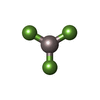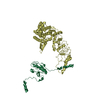+Search query
-Structure paper
| Title | A structural vista of phosducin-like PhLP2A-chaperonin TRiC cooperation during the ATP-driven folding cycle. |
|---|---|
| Journal, issue, pages | Nat Commun, Vol. 15, Issue 1, Page 1007, Year 2024 |
| Publish date | Feb 2, 2024 |
 Authors Authors | Junsun Park / Hyunmin Kim / Daniel Gestaut / Seyeon Lim / Kwadwo A Opoku-Nsiah / Alexander Leitner / Judith Frydman / Soung-Hun Roh /    |
| PubMed Abstract | Proper cellular proteostasis, essential for viability, requires a network of chaperones and cochaperones. ATP-dependent chaperonin TRiC/CCT partners with cochaperones prefoldin (PFD) and phosducin- ...Proper cellular proteostasis, essential for viability, requires a network of chaperones and cochaperones. ATP-dependent chaperonin TRiC/CCT partners with cochaperones prefoldin (PFD) and phosducin-like proteins (PhLPs) to facilitate folding of essential eukaryotic proteins. Using cryoEM and biochemical analyses, we determine the ATP-driven cycle of TRiC-PFD-PhLP2A interaction. PhLP2A binds to open apo-TRiC through polyvalent domain-specific contacts with its chamber's equatorial and apical regions. PhLP2A N-terminal H3-domain binding to subunits CCT3/4 apical domains displace PFD from TRiC. ATP-induced TRiC closure rearranges the contacts of PhLP2A domains within the closed chamber. In the presence of substrate, actin and PhLP2A segregate into opposing chambers, each binding to positively charged inner surface residues from CCT1/3/6/8. Notably, actin induces a conformational change in PhLP2A, causing its N-terminal helices to extend across the inter-ring interface to directly contact a hydrophobic groove in actin. Our findings reveal an ATP-driven PhLP2A structural rearrangement cycle within the TRiC chamber to facilitate folding. |
 External links External links |  Nat Commun / Nat Commun /  PubMed:38307855 / PubMed:38307855 /  PubMed Central PubMed Central |
| Methods | EM (single particle) |
| Resolution | 3.1 - 4.42 Å |
| Structure data | EMDB-35122, PDB-8i1u: EMDB-35199, PDB-8i6j: EMDB-35280, PDB-8i9q: EMDB-35284, PDB-8i9u: EMDB-35335, PDB-8ib8: |
| Chemicals |  ChemComp-ADP:  ChemComp-MG:  ChemComp-AF3: |
| Source |
|
 Keywords Keywords |  CHAPERONE / CHAPERONE /  chaperonin complex / cochaperone / chapronin complex chaperonin complex / cochaperone / chapronin complex |
 Movie
Movie Controller
Controller Structure viewers
Structure viewers About Yorodumi Papers
About Yorodumi Papers














